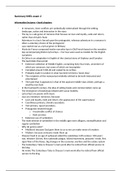Summary IMEL exam 2
Information lectures + book chapters
- In romances, inner conflicts are symbolically externalised through the setting,
landscape, action and interaction in the story
- The lay is a sub-genre of romance that focuses on love and loyalty, exile and return,
rather than chivalric feats
- Adventure in a lay is forced upon the protagonist, whereas adventure in a romance is
often a voluntary choice of the protagonist
- Lays started out as a lyrical genre in Brittany
- Marie de France composed twelve narrative lays in Old French based on the narrative
lays accompanying Breton lyrical lays -> her lays were used as models for the English
narratives
- Sir Orfeo is an adaptation in English of the classical story of Orpheus and Eurydice
- The Auchinlek Manuscript:
Extensive collection of Middle English, containing forty-four texts, seventeen of
which are romances, but some of which are incomplete
Compiled around 1330-40 and copied by six scribes
Probably made in London in what has been termed a ‘book shop’
The recipients of the manuscript evidently wished to be both instructed and
entertained
The taste that it appeals to is that of the aspirant middle-class citizen, perhaps a
wealthy merchant
- In the fourteenth century, the idea of selling books and commercialism came up
- The emergence of bookshops helped with social mobility
- Lyrical lays are poems with music
- Lays are miniature romances, because:
Love and loyalty, exile and return, the appearance of the supernatural
Courtliness primary, chivalry secondary
Test primary, quest secondary
Protagonist tested through:
o Irresolvable conflict of choices
o Rash promise
Extensive use of symbolism
- The main division of symbolism in the middle ages were allegory, exemplification and
regular symbolism
- Why do genres exist?
Medieval: because God gave them to us so we can make sense of creation
Modern: because someone made them up
- Chaucer lived in an age of upheaval called the calamitous 14th century: 100 years’
war, Western Schism, first outbreaks plague, lollard movement, peasants’ revolt, first
signs Wars of the Roses, big changes in the economy, warfare and the estate system
- The Canterbury Tales is Chaucer’s main work after he retired from official service to
the king
- He wrote The Canterbury Tales is Chaucer’s main work after he retired from official
service to the king
, - He wrote The Canterbury Tales in the period 1387-1400, but he had already written
some tales as individual stories before that time. He died before he could finish the
whole book
- Educated at least to grammar-school level, Chaucer was employed as a government
officer
- Chaucer served in the household of Richard II during the 1380s
- Chaucer was born in a merchant family = non-estate group
- Chaucer’s first phase was his French phase
- His middle phase was inspired by Italian literature = very different from French. Italy
had already entered the renaissance
- After he retired, he reached his last phase = English
- The Canterbury Tales as a new type of narrative -> a product of Chaucer’s life:
Diplomatic missions on the continent
Saw people of all walks of life -> led to different characters
- The Canterbury Tales were also a product of contemporary literary culture:
In English
Framework narrative
Wide audience
- Practical science operated not just within the confines of what we would term
scientific in modern contexts, but also in areas that are no longer seen as scientific,
such astrology, divination and magic
- Over 90 percent of all vernacular writings in medieval Europe pertained to practical
science
- Astrology can be used to diagnose an illness based on the moment a patient consults
a physician
- Divination and prognostication used all kinds of signs to interpret the future
- The York Company of Barber-Surgeons had three functions:
Served a religious purpose by performing its own mystical plays
Controlled the professional standard of work by supervising old and educating
new members
Set the fees and took care of the social welfare of its members
- The Guild-Book of the Barber-Surgeons of York is an illuminated display volume that
also served as an official document for recording historical facts:
It was begun in the fifteenth century, continued in 1592 and intermittently to
1757
Writing is mostly in English, but Latin is also used in places, which could imply that
it was part of the education of barber-surgeons
- A picture of the zodiacal man shows the influence of the signs of the zodiac on the
human body
- Volvelle = a highly professional instrument for defining the position of the sun and
the moon in the signs of the zodiac
- The main themes of the zodiacal lunaries are the agenda, medical and surgical
operations, and administering medicine
- The philosophical basis lies in the belief in the correspondence between the
macrocosm of the universe and the microcosm of man
- The signs were divided into movable, common and stable, feminine and masculine,
hot and cold




